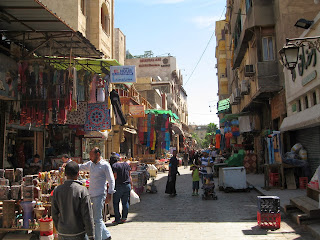Hurghada is an interesting town. Apparently it is a very popular vacation spot
for Russians- important enough for all the signs to Arabic, English, and
Russian. After completing the long
check-in process, we got to our rooms where we frantically showered and got
dressed for dinner. We ate on a covered
deck right by the sea. It was our last
night as a group, so we stayed up a long time, eating, dancing, attempting S’s
poi balls, and talking to a very drunk Russian.
 Then it was back on the bus to Cairo. As we followed the coastline north, we saw Sinai
in the distance, including a mountain sharing the name, if not the exact
location, of the mountain Moses climbed. We debriefed and said goodbye to those with
early flights. Those of us who did not
need to sleep early stayed up and talked before another round of goodbyes.
Then it was back on the bus to Cairo. As we followed the coastline north, we saw Sinai
in the distance, including a mountain sharing the name, if not the exact
location, of the mountain Moses climbed. We debriefed and said goodbye to those with
early flights. Those of us who did not
need to sleep early stayed up and talked before another round of goodbyes.
The next morning we boarded the Prince Mosleh and cruised
out to snorkel in the Red Sea. Every
place we’d been in Egypt prior to this day was hot. However, the day we were spending in the
water was windy. Very windy. The wind made it a little chilly but the
water was incredibly blue, as was the sky, and I was getting in regardless of
the temperature.
As we were cruising out to a reef, I could see little jelly
fish in the water below. I currently
have a 60% sting rate for salt water body jelly fish stings. I really started to worry once I saw those
little guys floating along. However,
once we reached the reef, they seemed to be gone and we all jump in for a
tour. I saw parrot fish (which eat coral
and poop sand) and angel fish and even clown fish. It was really nice.
We also jumped off the top deck and attempted to get
pictures of us jumping off in sync. J finally
succeeded in making a time lapse photo series of all of us plunging into the
water. I then tried to get dry and
warm(er) and we all ate lunch. We
visited one other snorkel site before heading back in.
 Then it was back on the bus to Cairo. As we followed the coastline north, we saw Sinai
in the distance, including a mountain sharing the name, if not the exact
location, of the mountain Moses climbed. We debriefed and said goodbye to those with
early flights. Those of us who did not
need to sleep early stayed up and talked before another round of goodbyes.
Then it was back on the bus to Cairo. As we followed the coastline north, we saw Sinai
in the distance, including a mountain sharing the name, if not the exact
location, of the mountain Moses climbed. We debriefed and said goodbye to those with
early flights. Those of us who did not
need to sleep early stayed up and talked before another round of goodbyes.
Several of us had an afternoon flight, so we asked S where
we could go shopping. He recommended Khan
el-Khalili Bazaar. The next morning the
hotel called us 2 cabs and after briefly commenting on their extremely sketchy un-cablike
appearance, we were quoted a reasonable fare, so we got in and hoped we ended
up in the right place. The jalopy I rode
in pulled up to the bazaar with the other car right behind us. After surviving that adventure we began to
shop. I bought some embroidered tunics
and several scarves (some were gifts, I swear!).
After making it
through the bazaar we needed to head back to catch the airport shuttle. However, first we had to catch a cab. That was a little nerve racking since we
couldn’t call one and we were on our own.
We stood on the corner and flagged a decidedly more cab-like cab down,
asked the price to get back to our hotel, and piled in. We made it back with no problems.
We all boarded the airport bus and weaved our way through
Cairo traffic for the last time. It
turned out that R from Australia, the first fellow Contikian I met upon arrival
was on the same flight as me to Vienna.
We were seated together right across the aisle from a horrible child
that cried and through temper tantrums for the entire 6 hours. This child also refused to sit down when we
were about to land and instead of making her (I mean really, she was like 3),
once the flight attendants made their final check, her mom just let her stand
back up. She was standing on the floor
when the plane landed. Parenting
fail.
I said “goodbye” to R and proceeded up the stairs to catch
my flight back to Sofia. By that time, I’d spent so much time in the Vienna
airport, I barely had to look at the signs to know where I was going. I successfully made it back to Sofia and had
serious trip hang-over for about the next month. It was probably the best trip I’ve ever been
on. The people were great, the sites
were great, and the experience was once in a lifetime. I’m so glad I got to go and I sincerely hope
that Egypt stabilizes soon so others can have the same opportunities and the
all the people who work in the tourist industry get their livelihoods
back.







